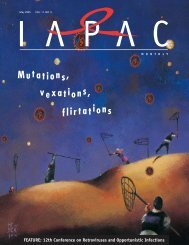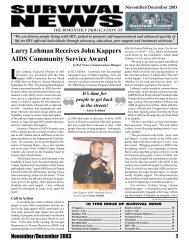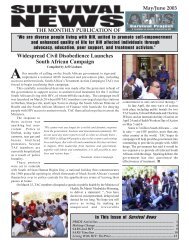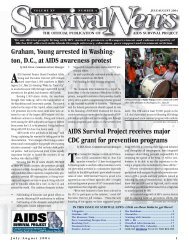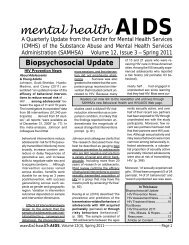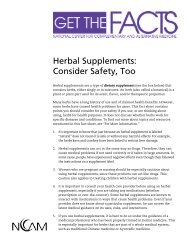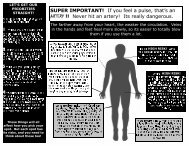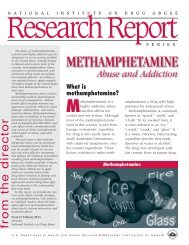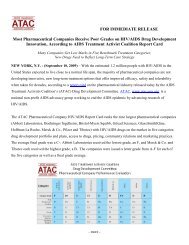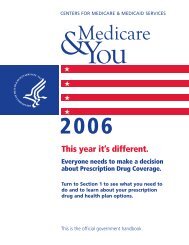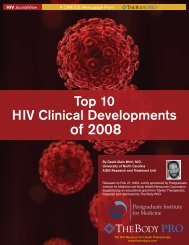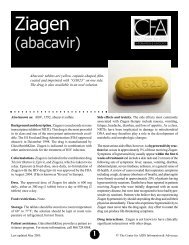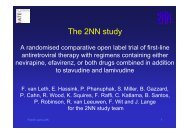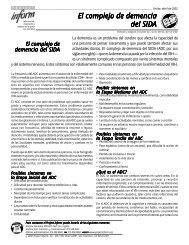HeAlTH INFormATioN & VieWs - CD8 T cells - The Body
HeAlTH INFormATioN & VieWs - CD8 T cells - The Body
HeAlTH INFormATioN & VieWs - CD8 T cells - The Body
Create successful ePaper yourself
Turn your PDF publications into a flip-book with our unique Google optimized e-Paper software.
with my clients’ doctors because<br />
I believe that a multidisciplinary<br />
approach ensures that clients get<br />
the best care possible.<br />
For clients who experience<br />
more pain when they walk or stand<br />
for long periods, we recommend<br />
custom-made orthotics and/or<br />
ortho pedic shoes, which relieve<br />
pressure from certain parts of the<br />
feet. For clients who have difficulty<br />
walk ing, I also recommend adaptive<br />
equipment, such as a cane or a<br />
walker with a seat, which allows<br />
people to sit down and offload<br />
mechanically induced foot pain. I<br />
recommend wheelchairs as a last<br />
resort for people who are not able<br />
to walk about. I want people to be<br />
mobile for as long as possible.<br />
When people have a combination<br />
of HIV, PN and type 2 diabetes,<br />
they can develop a loss of protec -<br />
tive sensation (LOPS) in their feet.<br />
Clients sometimes ask me, “What’s<br />
the big deal if I can’t feel?” LOPS<br />
puts people at risk for self-harm.<br />
For example, a person might walk<br />
along the floor barefoot and only<br />
realize they’ve stepped on a tack<br />
when they notice blood or the tack<br />
sticking into their foot. When this<br />
happens, the healing time may be<br />
longer for a person with HIV (due to<br />
immunosuppression) than for an HIVnegative<br />
person. And the wound might<br />
not heal adequately, which can potentially<br />
lead to serious complications. If<br />
you have LOPS, you should:<br />
● Examine your feet daily. If you<br />
can’t bend over or see your feet,<br />
put a mirror on the ground and<br />
place your feet over it.<br />
● Dry in between your toes after a<br />
bath or shower to prevent skin<br />
breakdown due to fungi, and wipe<br />
away flaky, dead skin in between<br />
the toes. If you can’t reach your<br />
toes, seeing a foot care nurse,<br />
chiropodist or podiatrist for regular<br />
nail and skin care is vital.<br />
● Don’t wear outdoor shoes in doors<br />
(to avoid tracking pebbles, glass<br />
and debris inside). You may want<br />
to wear an indoor shoe to protect<br />
your feet from sharp objects, banging<br />
them against a bedpost or<br />
Some people with PN use complementary<br />
and nutritional treatments<br />
to help their nerves recover from<br />
PN, a process that can take months<br />
or years.<br />
● Alpha-lipoic acid—an antioxi-<br />
dant used to treat PN.<br />
● B-complex vitamins—particu-<br />
larly vitamin B 12 injections.<br />
● Vitamin E—to help with oxygen<br />
metabolism and blood flow.<br />
● Essential fatty acids—from<br />
evening primrose oil and coldwater<br />
fish, such as wild salmon,<br />
sardines, mackerel and anchovies.<br />
● Acetyl-carnitine—which research<br />
has found to be helpful for treating<br />
PN. <strong>The</strong> acetyl form is not<br />
available in Canada but L-carnitine<br />
is available by prescription.<br />
● Acupuncture—performed by an<br />
experienced doctor of traditional<br />
Chinese medicine.<br />
● Deep tissue massage for limbs<br />
affected by PN—to help stretch<br />
and relax muscles.<br />
● Smoking cannabis—cannot help<br />
nerves recover, but can lessen<br />
pain for some people.<br />
Before taking any of these, be sure<br />
to talk to your doctor about your<br />
plan for tackling PN.<br />
other injury. Always wear socks<br />
with your shoes to protect your feet<br />
from seams in the shoe, which can<br />
irritate or hurt the skin.<br />
● When buying new shoes, always<br />
feel inside the shoes for anything<br />
that might irritate your feet.<br />
● Consider orthopedic or accommodative<br />
footwear. (Some insurance<br />
plans cover the costs of<br />
orthopedic shoes.)<br />
● Schedule regular checkups with<br />
your doctor or foot specialist.<br />
JOE DACEY<br />
Person living with hIV<br />
Dartmouth, Nova Scotia<br />
I was diagnosed with HIV in 1990<br />
and I first noticed a strange tingling in<br />
my feet and hands about three years<br />
ago. My PN rapidly became so bad in<br />
my feet that I couldn’t walk any distance.<br />
My doctor is convinced that<br />
the HIV drugs I took in the past<br />
caused my disease.<br />
When my PN started, I had a lot<br />
of pain in my feet and they felt<br />
extremely hot. Now I still have<br />
pain but my feet usually feel<br />
extremely cold. I take a low-dose,<br />
slow-release form of oxycontin four<br />
times each day. If the pain becomes<br />
excruciating, I take a faster-acting<br />
form of the drug. <strong>The</strong> drugs don’t<br />
get rid of the pain but they tone it<br />
down a little.<br />
Aside from the meds, what helps<br />
me most with the pain is my heating<br />
pad. I rest my heels on the heating<br />
pad on my ottoman, and then I<br />
wrap a blanket around my feet and<br />
the heating pad to keep the heat in.<br />
I’ve talked with my doctor about<br />
removing the pain receptors in my<br />
feet. But without my pain receptors,<br />
I could bump into something or<br />
break my toe and not even realize<br />
it. So, I just keep going the way I’m<br />
going. It’s about all I can do.<br />
Fortunately, I was able to get<br />
enough money together to buy a<br />
scooter and a power wheelchair. I<br />
use the wheelchair when Access-a-<br />
Bus [door-to-door transit for people<br />
with disabilities] picks me up for<br />
my medical appointments. I can<br />
walk around my apartment but I use<br />
the power chair to go anywhere else.<br />
Typically, I feel best in the morning. On<br />
nice mornings, I spend some time outside<br />
before the pain gets too bad. I<br />
can’t wear shoes or even light socks<br />
because of the pain. In the summer, I<br />
can wear flip-flops outside but I have<br />
to be careful to not expose myself to<br />
the sun for too long because that can<br />
cause other problems due to the HIV<br />
medication I take.<br />
Of course, it’s very uncomfortable<br />
and frustrating. <strong>The</strong> thing that keeps<br />
me going is that I look around and see<br />
that some people are much worse off<br />
than I am healthwise. I wouldn’t wish<br />
this on anyone but it would be nice to<br />
know someone else who has PN. We<br />
might be able to exchange tips.<br />
Maybe this article will get people talking<br />
and I’ll meet someone else who<br />
has PN. In the meantime, I try not to<br />
let it get to me. ✚<br />
Summer 2012 THE POSITIVE SIDE<br />
27



